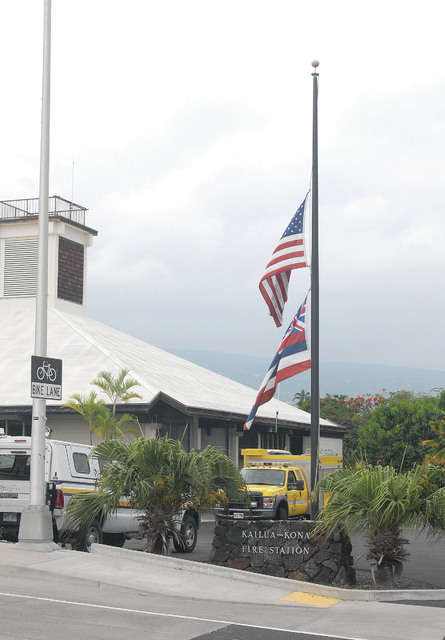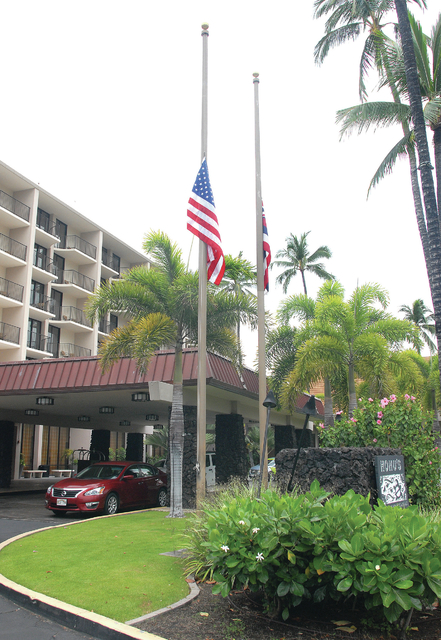KAILUA-KONA — Star spangled banners over Kona have flown lower as of late — or at least some of them have.
KAILUA-KONA — Star spangled banners over Kona have flown lower as of late — or at least some of them have.
Several half-staff orders have been issued by either President Barack Obama or Gov. David Ige in recent months, honoring victims of an attack on a Bastille Day crowd in France as well as murdered police officers within U.S. borders — to name a few.
The somber symbolism is mandatory outside federal and state facilities, but proprietors and homeowners are free to fly their flags as they please, which has led to some discontent throughout the Kona community.
“Coming from a military family, my opinion is if you’re going to fly the flag, then you need to be respectful,” said Gaylene Hopson, a volunteer with the USO and VFW Auxiliary. “I guess you don’t have to do it, but what bothers me more is there are people out there … who don’t have a clue when they’re supposed to do it.”
Response throughout Kona to Hopson’s sentiment wasn’t one of disrespect or indifference, simply one lacking complete information.
Hopson noticed Monday while eating lunch on Alii Drive that King Kamehameha’s Kona Beach Hotel had raised its flag to the full height of the flagpole. It was a day included in a presidential half-staff order to honor victims in France.
She notified management, the half-staff order was verified by the staff and by Tuesday morning, the red, white and blue flapped lively at half-staff amid a makai breeze.
An employee said the hotel has tried intently to follow suggested procedure, as the flag out front has flown half-staff almost as frequently as it’s flown normally in recent weeks.
But the problem resides with the increasing number of presidential and gubernatorial orders. How to respectively fly an American flag is an almost constantly moving target.
“For the past, shucks, I can’t even remember when, maybe about a month now, the flag has been half-staff about half of the time,” said Mailei W., who works at the hotel. “Every time I watch the news it’s like, ‘Oh my God! Something else awful has happened.’”
Similar concerns have been voiced to the Kona Coast Shopping Center, which receives calls more or less weekly regarding proper flag procedure. Public inquiry has been so frequent, in fact, management actually called the Veterans Association out to verify its flag flying practices.
The list of rules surrounding flag etiquette is long, including from which side of the pole the flag should hang, that the American flag must hang at a greater height than any accompanying banners, and if the flag is flown at night, that it must be continuously lit by a spotlight.
Cindy McMillan, communications director for Gov. Ige, said facilities and homeowners may sign up for an email list through the governor’s office, which details when and why half-staff orders are issued.
David Carlson, commander of the American Legion chapter in Kailua-Kona and a former Air Force Captain, said inadvertent insult from a lack of half-staff knowledge tends to resonate most in segments of the population with strong military ties — a group he says is dwindling.
Carlson grew up in the shadow of World War II, when he said average citizens were more invested in war efforts, had more personal connections to them and felt foreign wars at home in a way that isn’t as prevalent now.
Fewer military ties in modern-day America might explain a greater number of individuals and businesses inadvertently overlooking half-staff orders. But Carlson made sure to point out not every veteran is as insistent about how the flags of private citizens and businesses are flown.
“I’m always proud when anybody raises an American flag, so it doesn’t bother me if they’re not aware there has been a requirement the flag be put at half-mast, or if they just don’t get around to it,” Carlson said. “That is all fine with me. As long as someone is willing to raise a flag, that is what is really important to me.”
Carlson added signs of solidarity within U.S. borders — like hoisting a flag — are more important now than ever, as the nature of war and the enemies of America and democracy have so drastically changed.
“You used to have an enemy,” he said. “Now, you have an enemy, but you don’t have any idea what he looks like or who he is until he starts killing you. It’s (sad) to think so many people are trying to spread it out and say anyone who is a Muslim is an enemy or some such stupid phraseology. It’s just about how do you protect yourself? It’s a problem.”
Hopson echoed Carlson’s exasperated sentiment regarding the current state of the country and the most recent string of horrific events, which have sent flags bobbing up and down on flagpoles on a seemingly endless basis.
She offered a solution which might eliminate questions about whether an American flag should fly half-staff, or what it means if a half-staff order is issued and individuals or businesses fail to acknowledge it.
“People need to ask themselves what’s going on,” Hopson said. “Does the flag need to fly half-mast? Or do we just need to flip it upside down and say to everyone, ‘The United States is in distress.’”


